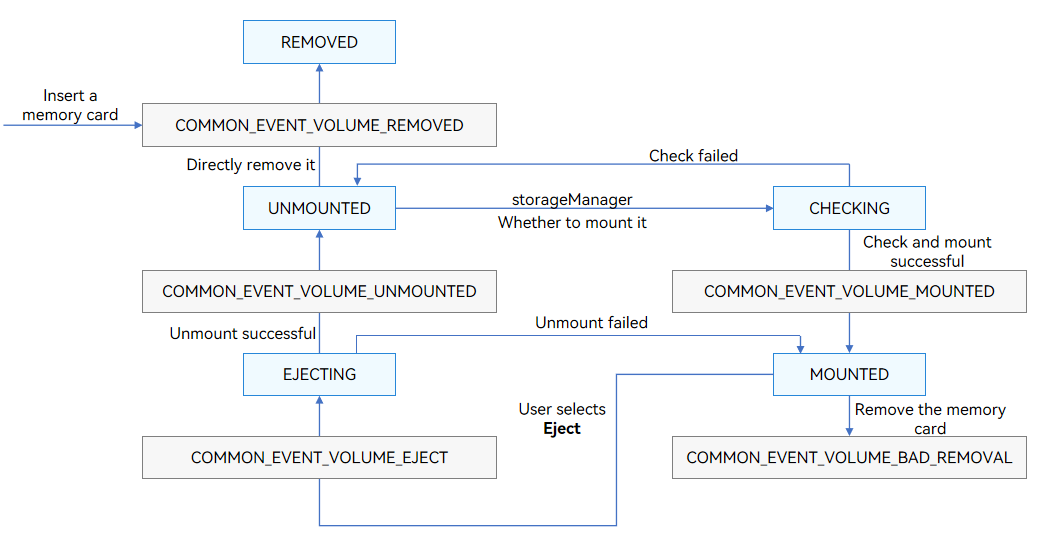Managing External Storage Devices (Available Only for System Applications)
External storage devices are pluggable. OpenHarmony provides the functions of listening for the device insertion and removal events and mounting/unmounting an external storage device.
External storage devices are managed by the StorageManager and StorageDaemon services. StorageDaemon implements the underlying listening and mount/unmount functions. StorageManager provides status change notifications, query, and management capabilities for system applications.
Figure 1 External storage device management

-
When an external storage device is inserted, the StorageDaemon process obtains an insertion event over netlink and creates a disk device and volume. The created volume is in the UNMOUNTED state.
-
Then, the StorageDaemon process checks the volume. During the check process, the volume is in the CHECKING state.
- The StorageDaemon process mounts the volume if the check is successful. If the mount operation is successful, the volume state changes to MOUNTED and StorageManager is instructed to send the COMMON_EVENT_VOLUME_MOUNTED broadcast.
- If the check fails, the volume state changes to UNMOUNTED.
-
For a volume in the MOUNTED state:
- If the device is directly removed, the volume information will be deleted and COMMON_EVENT_VOLUME_BAD_REMOVAL is broadcast.
- If the user chooses Eject device, the volume state changes to EJECTING and the COMMON_EVENT_VOLUME_EJECT is broadcast. After StorageDaemon unmounts the volume, the volume state changes to UNMOUNTED and COMMON_EVENT_VOLUME_UNMOUNTED is broadcast.
-
For a volume in the UNMOUNTED state, removing the device will delete the volume information and broadcast COMMON_EVENT_VOLUME_REMOVED.
Available APIs
For details about APIs, see Volume Management.
The following table describes the broadcast related parameters.
Table 1 Broadcast parameters
| Broadcast | Parameter |
|---|---|
| usual.event.data.VOLUME_REMOVED | id: ID of the volume. diskId: ID of the disk to which the volume belongs. |
| usual.event.data.VOLUME_UNMOUNTED | id: ID of the volume. diskId: ID of the disk to which the volume belongs. volumeState: state of the volume. |
| usual.event.data.VOLUME_MOUNTED | id: ID of the volume. diskId: ID of the disk to which the volume belongs. volumeState: state of the volume. fsUuid: universally unique identifier (UUID) of the volume. path: path where the volume is mounted. |
| usual.event.data.VOLUME_BAD_REMOVAL | id: ID of the volume. diskId: ID of the disk to which the volume belongs. |
| usual.event.data.VOLUME_EJECT | id: ID of the volume. diskId: ID of the disk to which the volume belongs. volumeState: state of the volume. |
How to Develop
Subscribe to broadcast events to notify the insertion and removal of external storage devices. The volumes can be queried and managed based on the volume information obtained from the broadcast.
-
Apply for permissions. Apply for the ohos.permission.STORAGE_MANAGER permission for subscribing to volume broadcast events. For details, see Declaring Permissions in the Configuration File.
-
Subscribe to broadcast events. Subscribe to the following events:
- "usual.event.data.VOLUME_REMOVED": The device is removed.
- "usual.event.data.VOLUME_UNMOUNTED": The volume is unmounted.
- "usual.event.data.VOLUME_MOUNTED": The volume is mounted.
- "usual.event.data.VOLUME_BAD_REMOVAL": The device is forcibly removed.
- "usual.event.data.VOLUME_EJECT": The device is being ejected.
import CommonEvent from '@ohos.commonEventManager'; import volumeManager from '@ohos.file.volumeManager'; const subscribeInfo = { events: [ "usual.event.data.VOLUME_REMOVED", "usual.event.data.VOLUME_UNMOUNTED", "usual.event.data.VOLUME_MOUNTED", "usual.event.data.VOLUME_BAD_REMOVAL", "usual.event.data.VOLUME_EJECT" ] }; let subscriber = await CommonEvent.createSubscriber(subscribeInfo); -
Obtain the volume information from the broadcast.
CommonEvent.subscribe(subscriber, function (err, data) { if (data.event === 'usual.event.data.VOLUME_MOUNTED') { // Manage the volume device based on the information obtained from the broadcast. let volId = data.parameters.id; volumeManager.getVolumeById(volId, function(error, vol) { if (error) { console.error('volumeManager getVolumeById failed'); } else { console.info('volumeManager getVolumeById successfully, the volume state is ' + vol.state); } }) } })